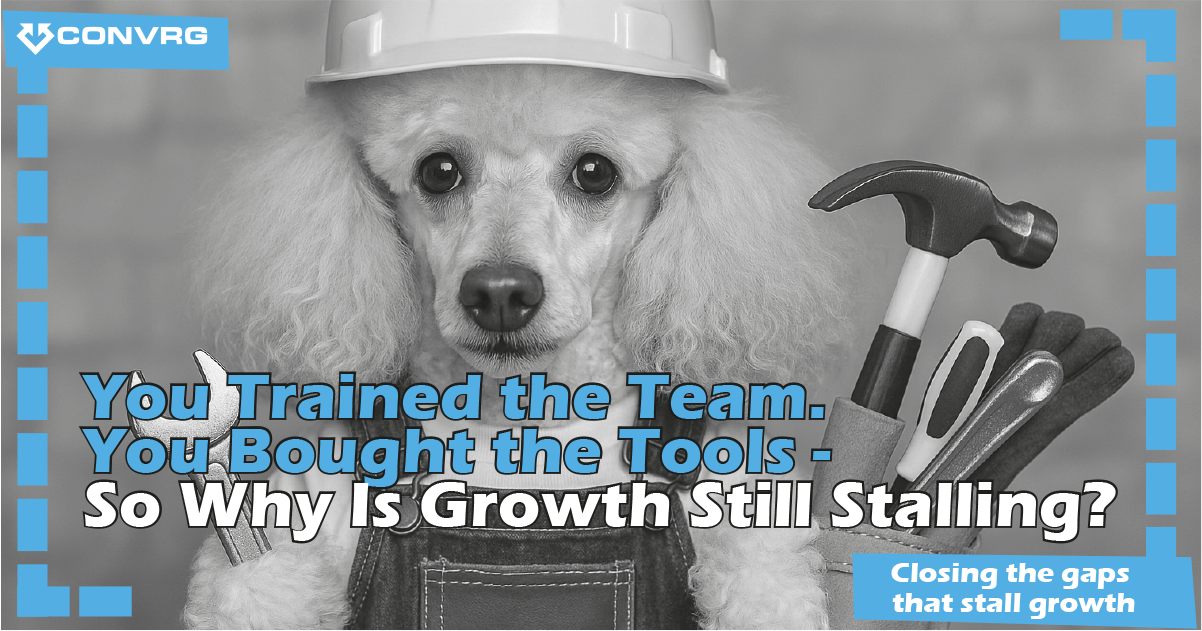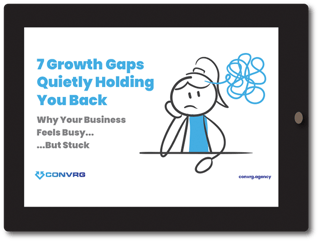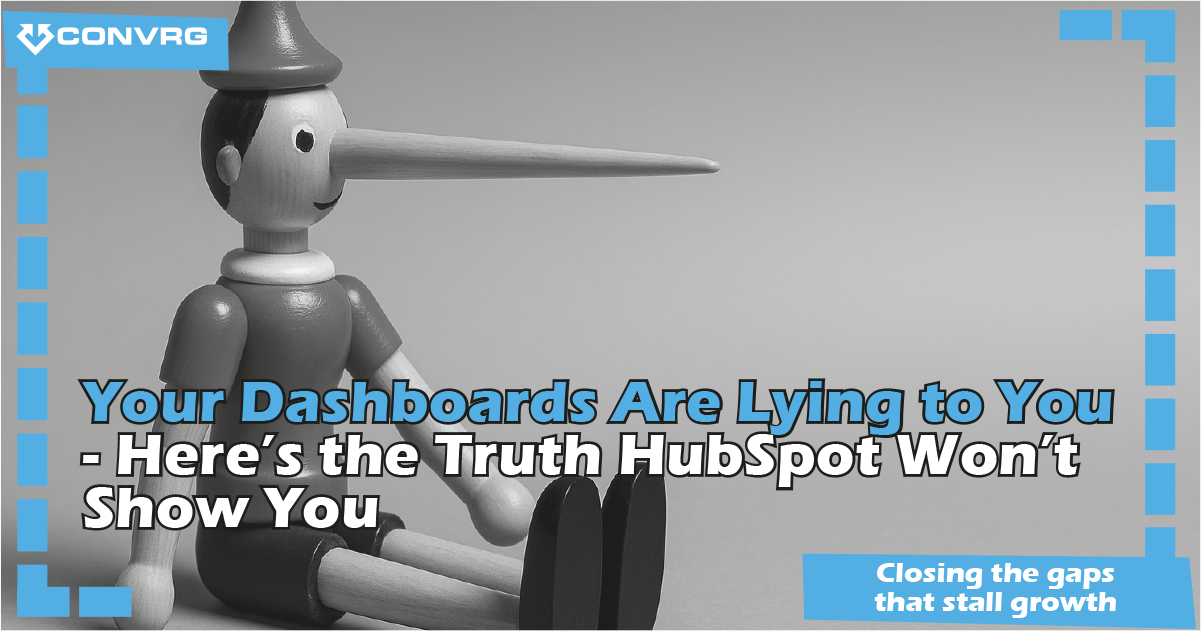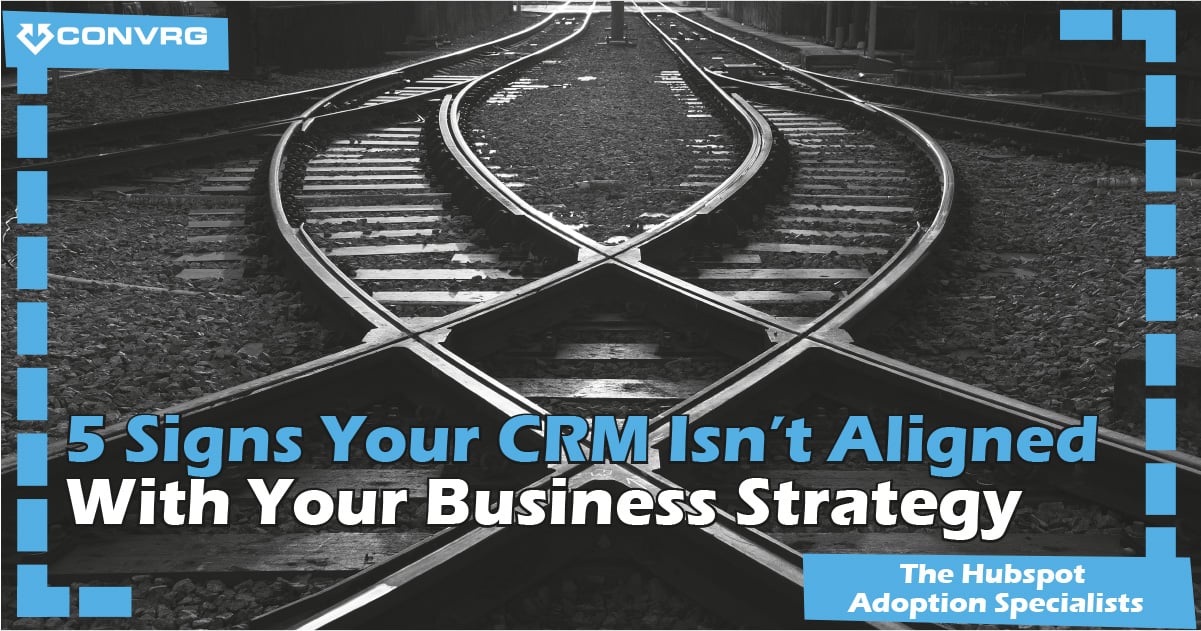You hired smart people.
You invested in great tools.
You ran the training.
You did the offsite.
You brought in the consultants.
And yet…
- Execution is still inconsistent
- Teams are still siloed
- Data is still questionable
- Customer experience is still hit-and-miss
- Growth has slowed, and nobody can agree on why
We see this all the time in ambitious B2B businesses.
From the outside, everything looks fine:
Great product. Great team. Great tech stack.
But under the surface?
Friction. Frustration. Fatigue.
You’re stuck in what we call the Growth Gap - and you’re not alone.
When More Isn’t Better
Most businesses hit a stage where their original operating model just can’t keep up with their ambition.
So they do what seems logical:
- Add tools
- Add training
- Add meetings
- Add headcount
But none of that solves the core problem - because the real issue isn’t knowledge or effort.
It’s the system.
Tools can’t fix misalignment.
Training can’t fix unclear processes.
Growth can’t scale on top of chaos.
And unless you change the underlying way the business runs, you’ll keep pouring effort into something that’s quietly pulling itself apart.
Let’s be clear - more input without alignment creates noise, not momentum. It’s not a matter of working harder. It’s about working smarter, with systems that guide decisions, processes that are visible and followed, and a rhythm that connects every team to a shared goal.
The Hidden Forces Slowing You Down
Let’s be clear - it’s not that your team is underperforming.
They’re probably doing their best.
But even the best teams struggle when the system is broken.
Here are five forces we see inside nearly every business that’s stalling out - despite having tools, training, and talent.
- Everyone’s Working Hard - But Not Together
You’ve got great people. But they’re operating in silos.
- Marketing is building assets without Sales input
- Sales is tweaking pricing without telling Ops
- Ops is drowning in delivery changes they didn’t see coming
Each team is solving the problems in front of them - but no one’s working across the business.
That lack of shared context is death by a thousand cuts.
It shows up in duplicated work, missed handovers, and misaligned KPIs. Each team believes they're doing what's right for the business, but their definitions of success are out of sync. This isn't a people issue - it's a structural one.
- There’s Activity - But No Real Rhythm
You’ve got dashboards. You’ve got meetings. You’ve got reports.
But nobody really trusts the data.
Decisions are reactive.
Execution is choppy.
The business is busy - but not in sync.
If every team has their own version of “what good looks like”, you don’t have a rhythm - you have chaos with structure on top.
Without a shared cadence - like weekly GTM syncs, aligned KPIs, or quarterly retros - activity becomes fragmented. Teams build their own calendars, set their own priorities, and slowly drift out of alignment with each other and the business as a whole.
- Your Tools Are Misunderstood or Misused
You’ve got HubSpot. Or Salesforce. Or Notion. Or Asana. Or all of the above.
But...
- No one’s using them consistently
- There’s double entry and workarounds
- You’re still doing reporting in spreadsheets
This isn’t a tech problem.
It’s a system design problem.
Without a clear operating model that tells teams how tools fit into workflows and why they matter, adoption will always be partial and painful.
It’s common to assume poor adoption is a training issue - but more often it’s a signal of weak process design. Tools should follow the way teams work, not dictate it. If the system isn't intuitive or reinforced by leadership, people naturally default to what feels fastest - even if it's messier.
- Training Doesn’t Stick Without Structure
You can’t train your way out of a broken system.
We’ve seen this again and again:
- Sales training with no documented process
- CRM training with no agreed pipeline stages
- Customer success playbooks no one follows
If the business isn’t structurally aligned - if systems, handovers, and feedback loops aren’t in place - then training is just theory.
And theory doesn’t scale.
Great training needs reinforcement. That means job aids, coaching, documentation, and ongoing leadership support. But none of that works if the system the training sits in is undefined or constantly shifting beneath people's feet.
- Leadership Is Reacting Instead of Orchestrating
This is where it hurts the most.
As a senior leader, your time should be spent:
- Driving strategy
- Coaching performance
- Building scalable systems
But instead?
- You’re reviewing broken deals
- Fixing internal miscommunications
- Sitting in “alignment” meetings that don’t align anything
That’s a sign your business doesn’t have a growth operating system.
And without one, leadership is forced into firefighting mode - which creates a ceiling you can’t grow past.
When you’re solving the same problems repeatedly, it means your system isn’t solving them. Leadership gets sucked into operational bottlenecks because nobody else has the visibility, authority, or clarity to make confident decisions without them.
You Don’t Have a People Problem. You Have a Systems Problem.
Here’s the shift most businesses need to make:
From focusing on what people are doing - to rethinking how the business enables them to do it.
Because great teams can’t succeed inside broken systems.
And no amount of motivation, coaching, or dashboards will change that.
You don’t need more tools.
You don’t need more training.
You need a better system.
That’s why we developed the SIMPLIFI Framework.
The SIMPLIFI Framework: How Scaling Actually Happens
SIMPLIFI is our step-by-step approach to closing internal Growth Gaps.
It’s not a campaign. It’s not a CRM setup.
It’s an operating model - designed for leadership teams who know growth has to be structural, not just strategic.
Here’s what it helps you build:
- Shared direction
- Clear handovers
- Reliable data
- Embedded accountability
- Tools that fit real workflows
- Systems that get smarter as you grow
SIMPLIFI doesn’t give you a better CRM.
It gives you a business that actually uses one - because it fits how you work.
Let’s be honest:
- Your team isn’t ignoring the CRM because they’re lazy.
- Your processes aren’t broken because people are disorganised.
- Your growth isn’t stalling because you need one more training session.
You’re experiencing system failure.
SIMPLIFI is how we fix it - with leadership-led, system-supported execution.
Each phase of the framework helps you install the missing pieces your business needs to scale with clarity:
- Setting the Scene ensures the vision is aligned across the leadership team.
- Interview Everyone builds buy-in and uncovers the real blockers.
- Map the Processes brings visibility to your full customer journey.
- Plan the Way Forward gives you a phased, realistic rollout plan.
- Lead the Execution keeps leadership engaged through rhythm and reviews.
- Implement the Systems focuses on enablement and adoption.
- Fix What Breaks adds structured feedback loops and metrics.
- Iterate, Iterate, Iterate helps you scale what works - and evolve what doesn’t.
The First Step? Spot the Gaps
If growth has slowed, but nothing seems “technically wrong” - this is your wake-up call.
It means the warning signs are already showing.
The sooner you spot them, the sooner you can rebuild the foundation for sustainable growth.
[Download: The 7 Growth Gaps Quietly Holding You Back]
No fluff. Just clarity.
See which signals you’re ignoring - and what to do about them.
This is how you scale without breaking what made you successful in the first place.








